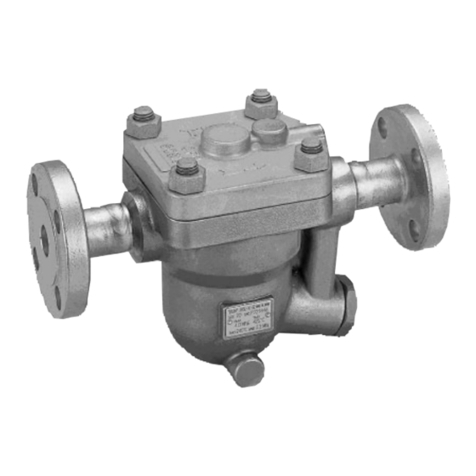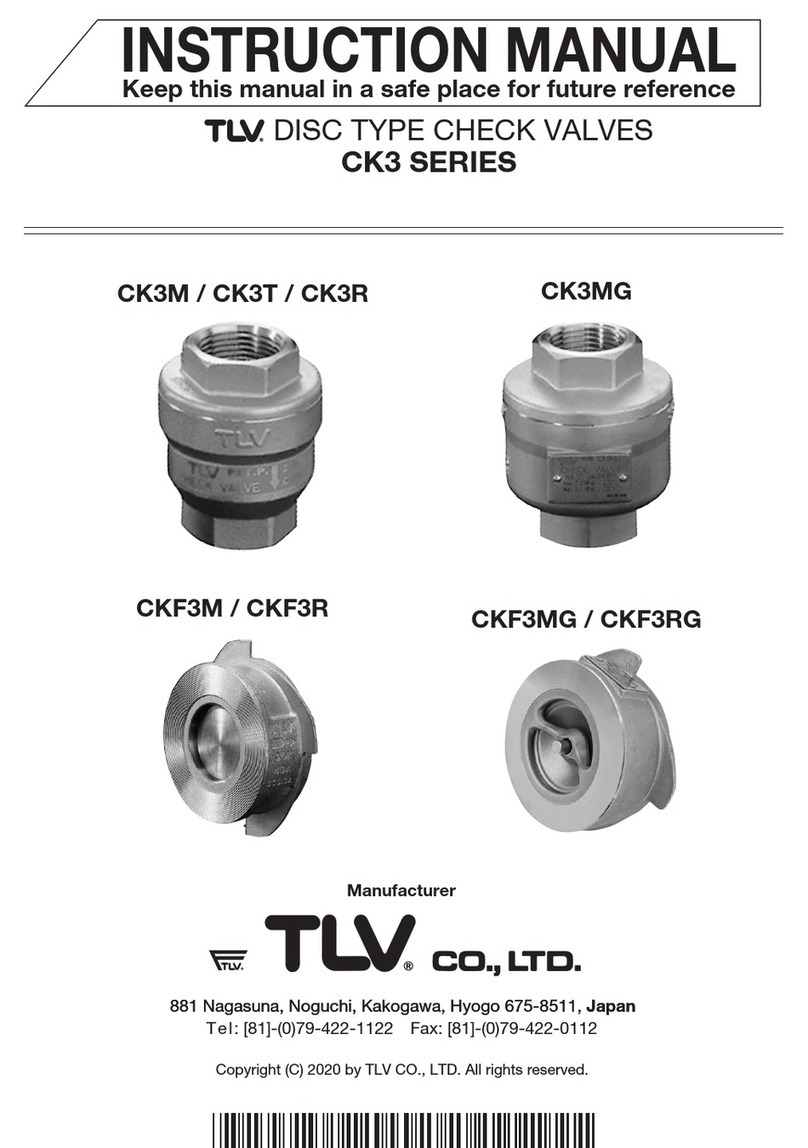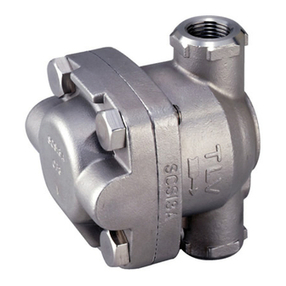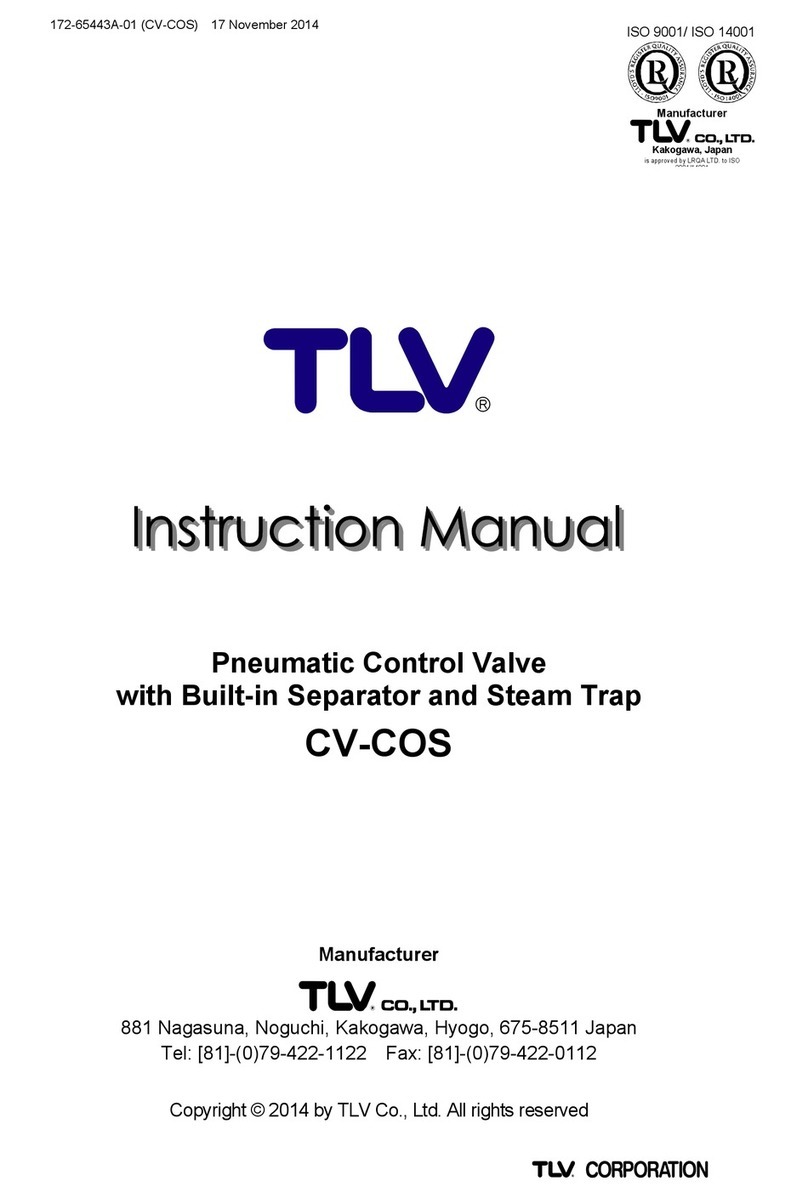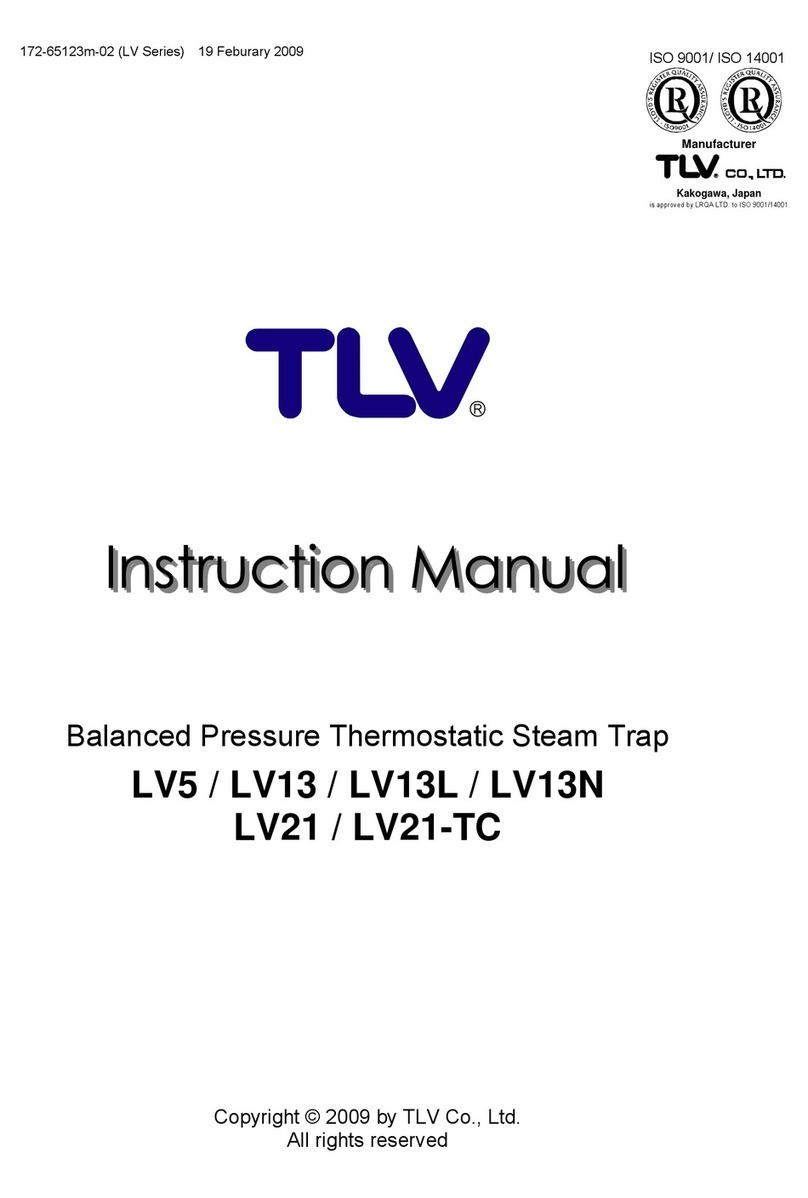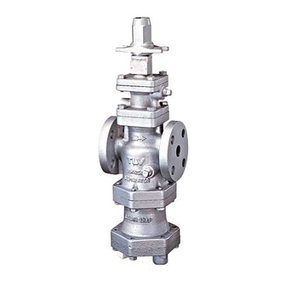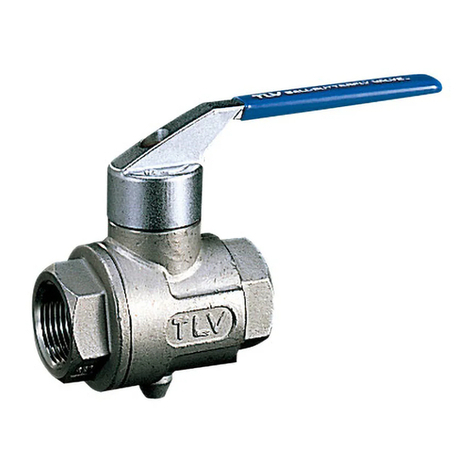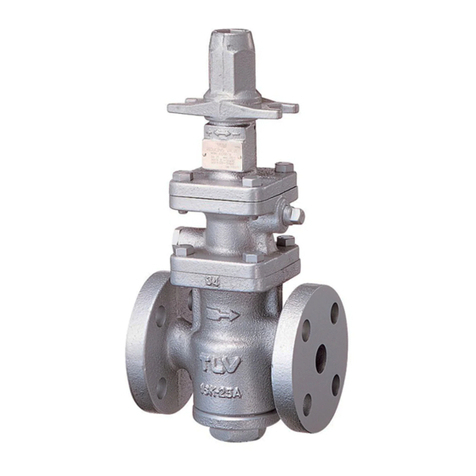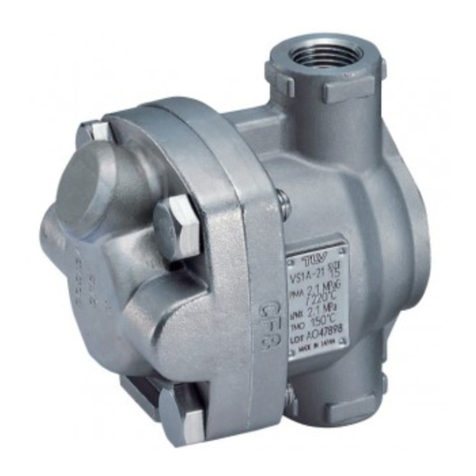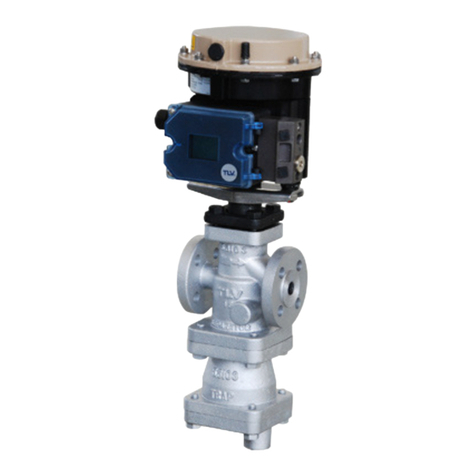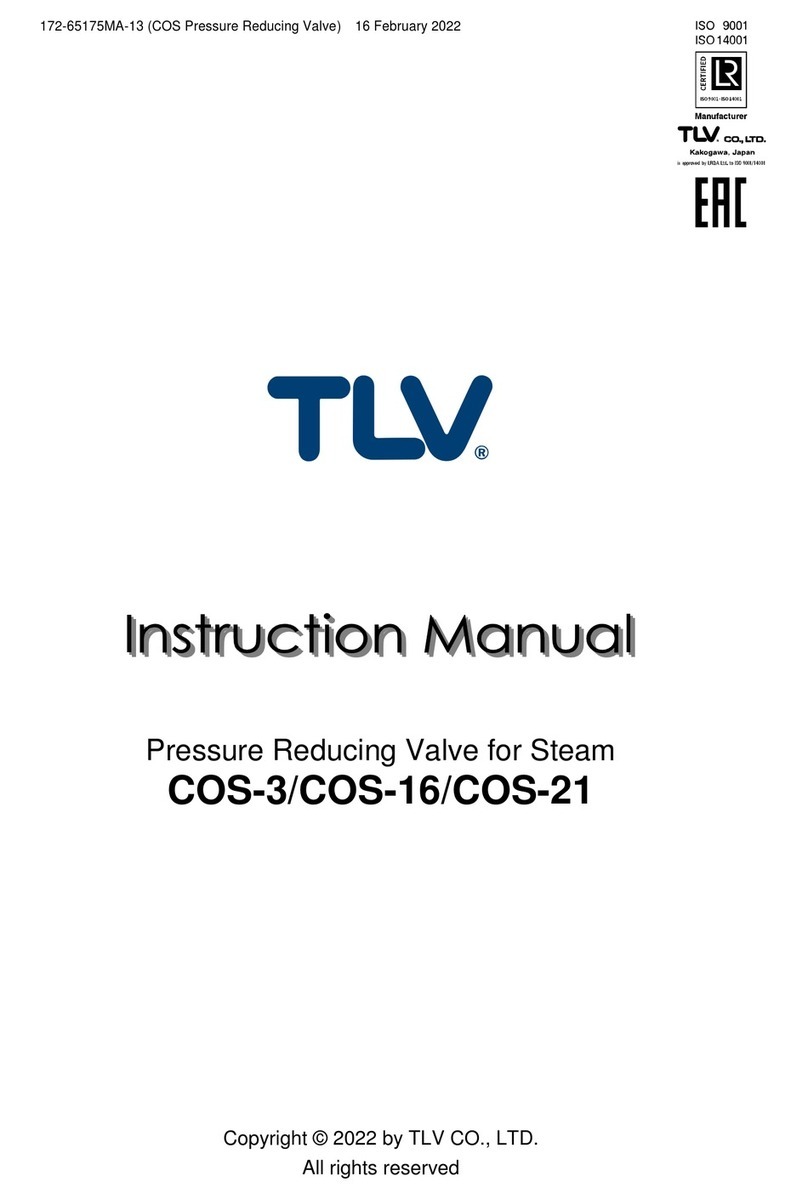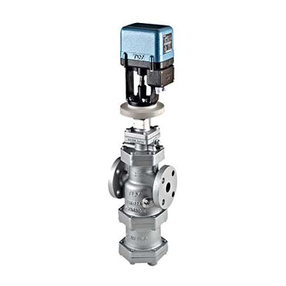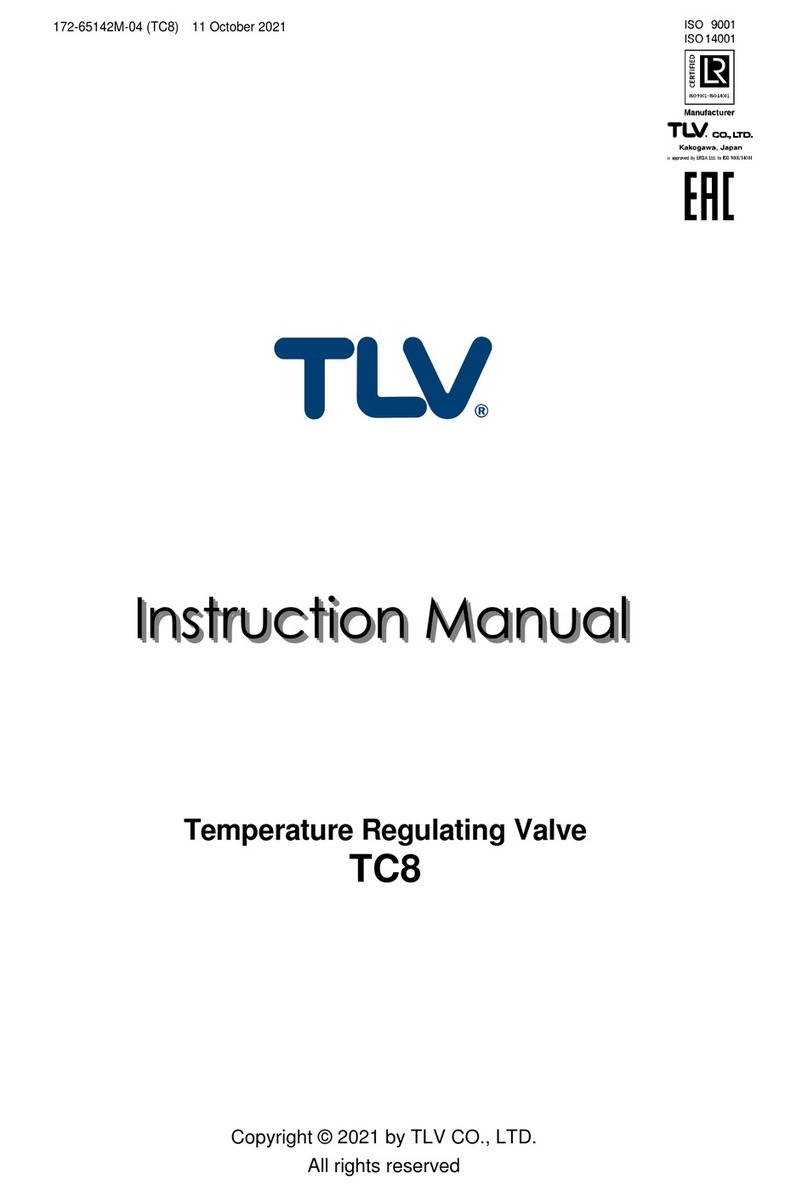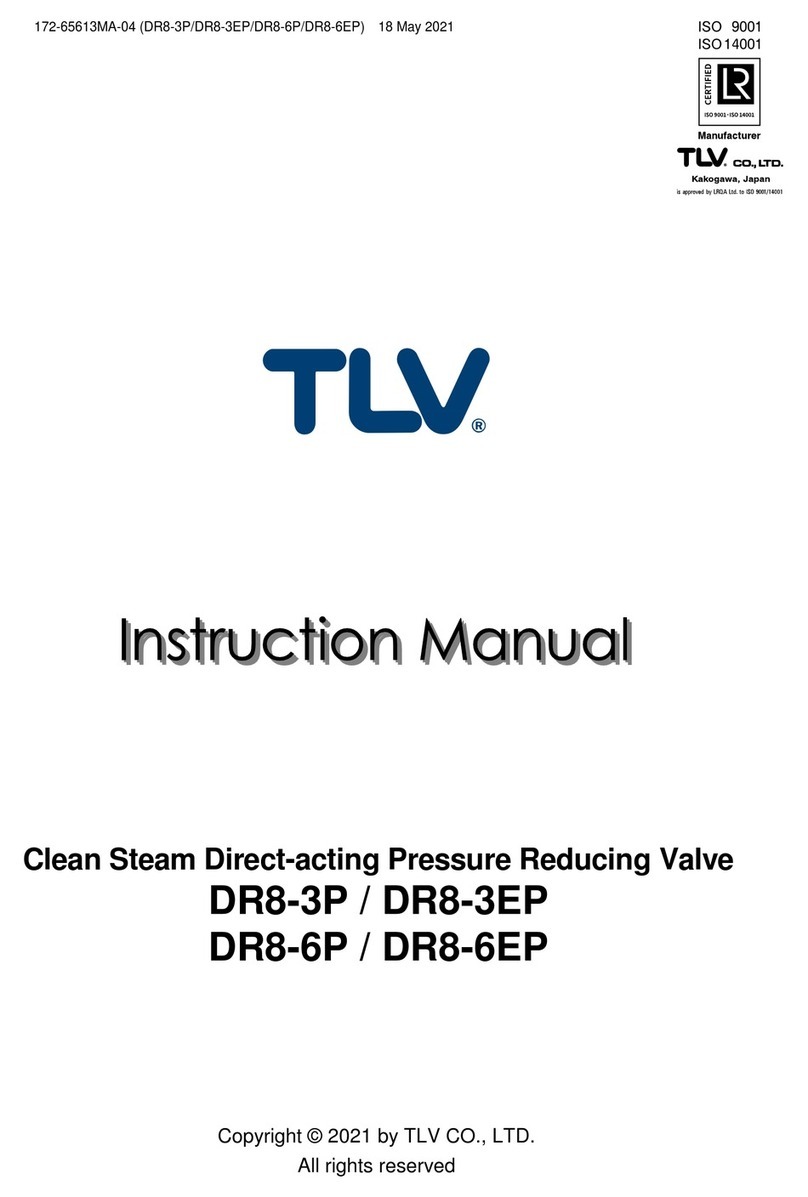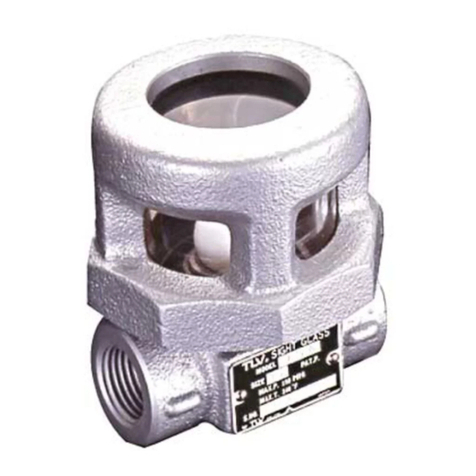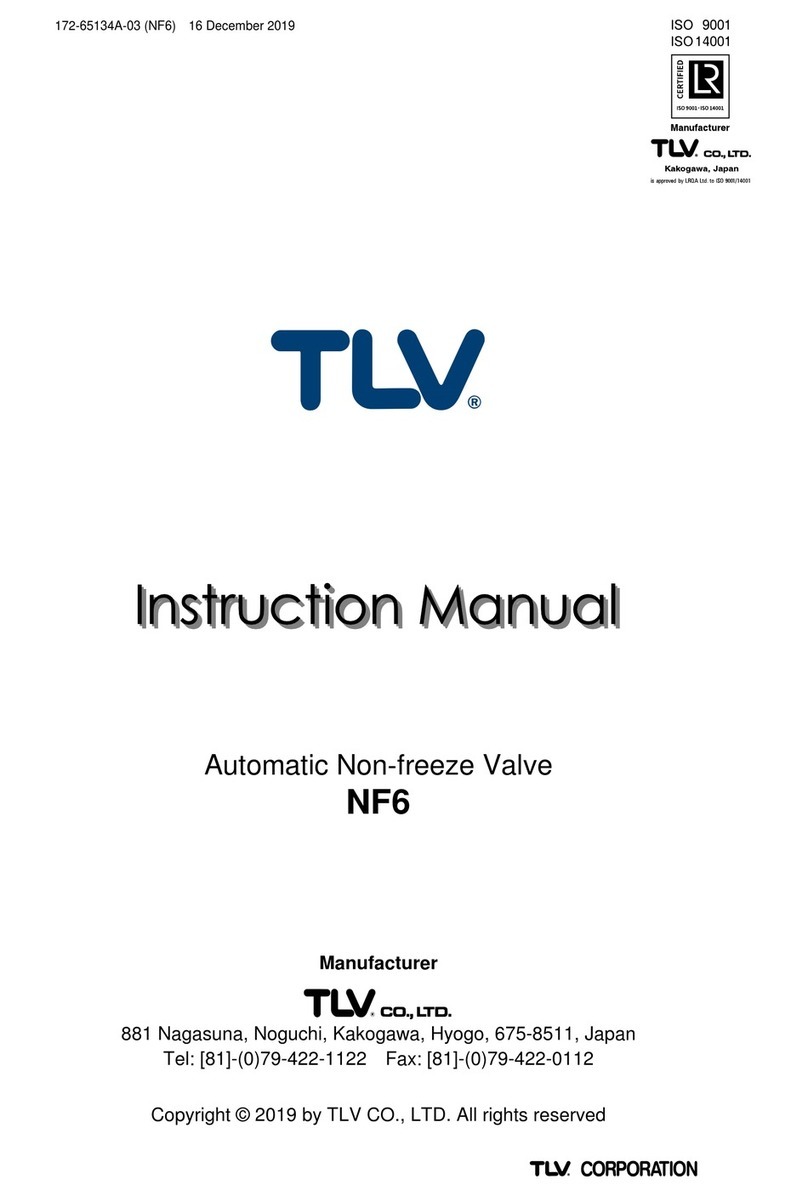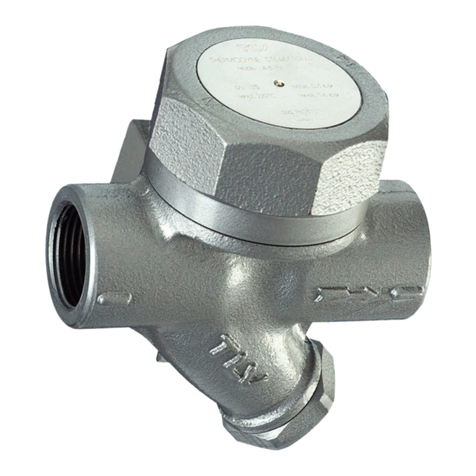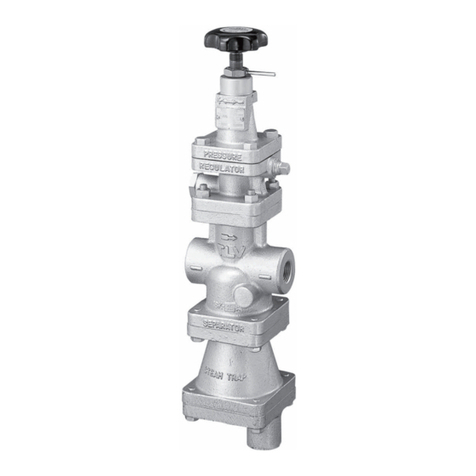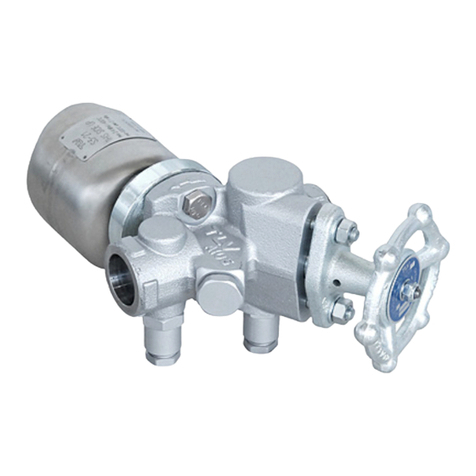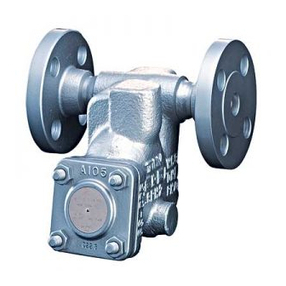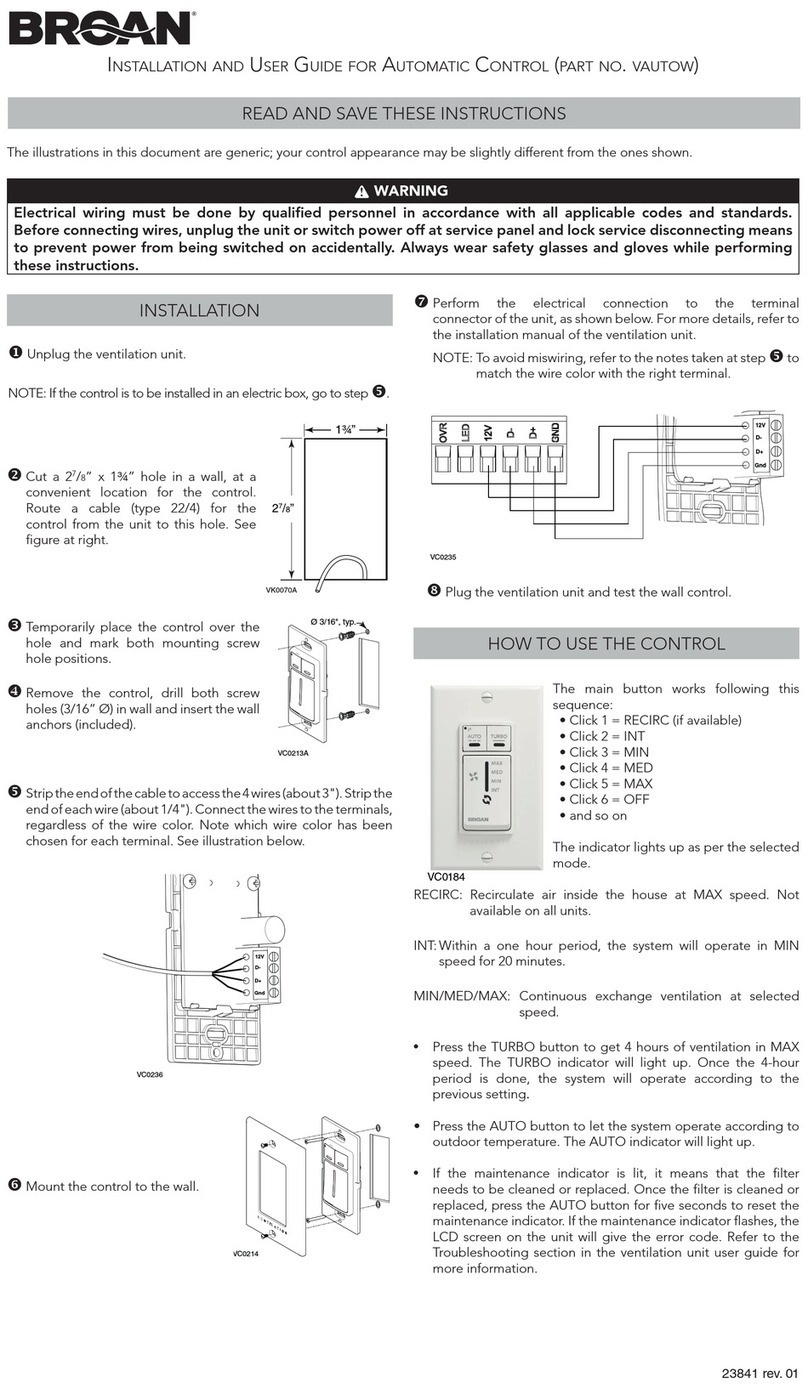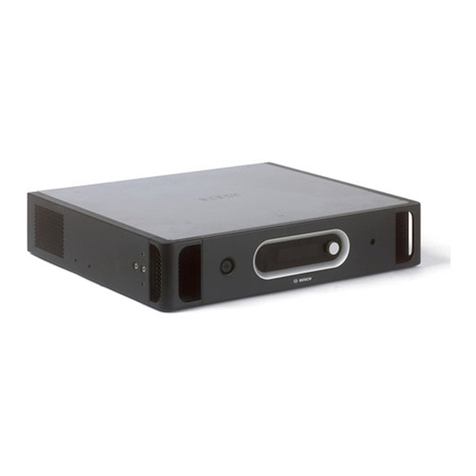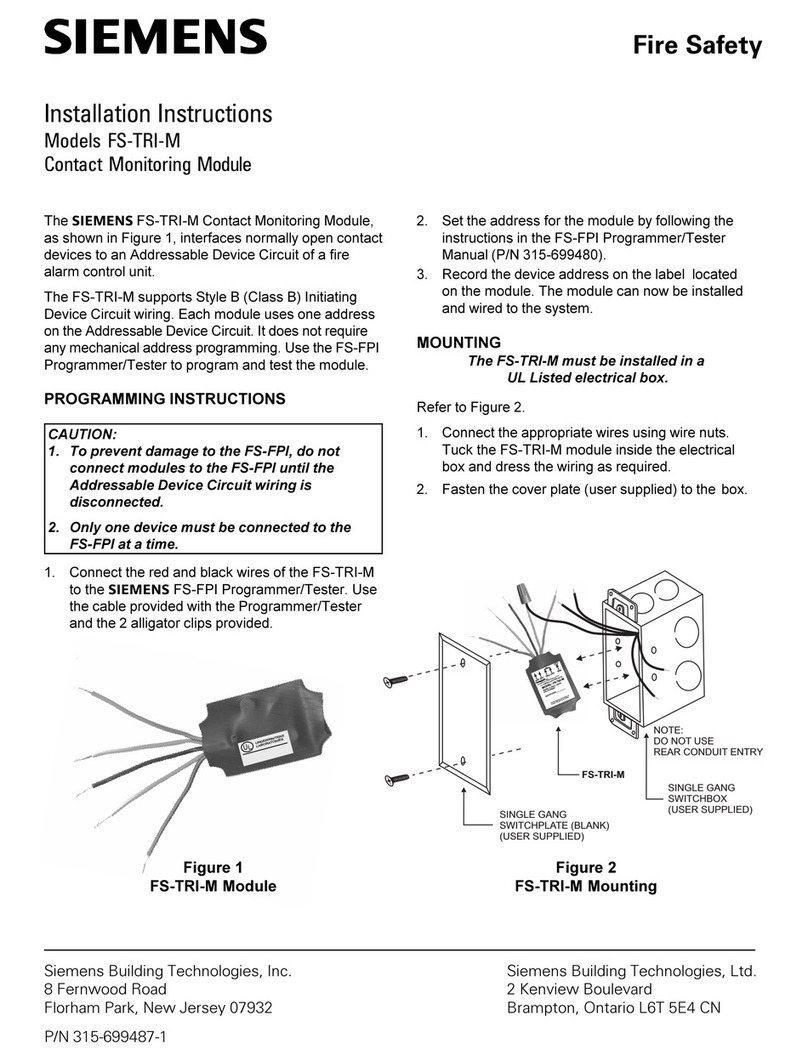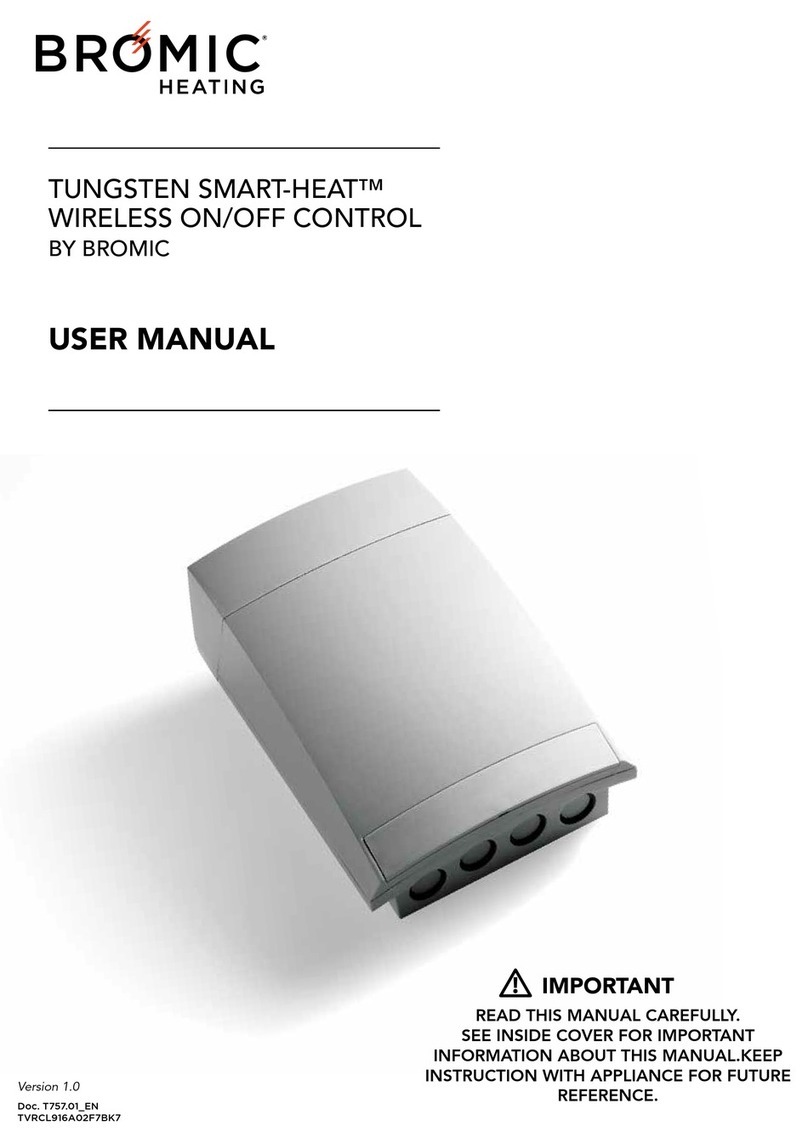TLV QUICK TRAP FS Series User manual

FS3/FS5/FS5H
Trap Unit
S3/S5/S5H
FREE FLOAT TYPE STEAM TRAPS
FS SERIES
INSTRUCTION MANUAL
Keep this manual in a safe place for future reference
Option
BD2
( )
Copyright (C) 2019 by TLV CO., LTD. All rights reserved.
881 Nagasuna, Noguchi, Kakogawa, Hyogo 675-8511, Japan
Manufacturer
Tel: [81]-(0)79-422-1122 Fax: [81]-(0)79-422-0112

Introduction
Before you begin, please read this manual to ensure correct usage of the product, and keep it in
a safe place for future reference.
The FS3/FS5/FS5H steam traps (trap units S3/S5/S5H and connector unit F46 or former
connector unit F32*), designed for installation in any inclination, are suitable for small and medium
capacity applications between 0.01 and 4.6 MPaG (1 and 650 psig); such as saturated and
superheated steam mains, branches, tracer lines and small-to-medium size process equipment.
The traps discharge condensate continuously and automatically at a temperature slightly lower
than saturation temperature.
* Configuration of F32 differs slightly from that of F46
1 MPa = 10.197 kg/cm2, 1 bar = 0.1 MPa
For products with special specifications or with options not included in this manual, contact TLV
for instructions.
The contents of this manual are subject to change without notice.
1. Safety Considerations
• Read this section carefully before use and be sure to follow the instructions.
• Installation, inspection, maintenance, repairs, disassembly, adjustment and valve
opening/closing should be carried out only by trained maintenance personnel.
• The precautions listed in this manual are designed to ensure safety and prevent equipment
damage and personal injury. For situations that may occur as a result of erroneous handling,
three different types of cautionary items are used to indicate the degree of urgency and the
scale of potential damage and danger: DANGER, WARNING and CAUTION.
• The three types of cautionary items above are very important for safety; be sure to observe
all of them, as they relate to installation, use, maintenance, and repair. Furthermore, TLV
accepts no responsibility for any accidents or damage occurring as a result of failure to
observe these precautions.
Indicates an urgent situation
which poses a threat of
death or serious injury.
Indicates that there is a
potential threat of death
or serious injury.
WARNING
CAUTION
WARNING
DANGER CAUTION
Indicates that there is a
possibility of injury or equip-
ment/product damage.
NEVER apply direct heat to the float. The float may explode due to
increased internal pressure, causing accidents leading to serious injury
or damage to property and equipment.
Install properly and DO NOT use this product outside the recommended
operating pressure, temperature and other specification ranges.
Improper use may result in such hazards as damage to the product or
malfunctions, which may lead to serious accidents. Local regulations may
restrict the use of this product to below the conditions quoted.
Take measures to prevent people from coming into direct contact
with product outlets. Failure to do so may result in burns or other injury
from the discharge of fluids.
DO NOT use this product in excess of the maximum operating pressure
differential. Such use could make discharge impossible (blocked).
Do not subject the trap to condensate loads that exceed its
discharge capacity. Failure to observe this precaution may lead to
condensate accumulation upstream of the trap, resulting in reduced
equipment performance or damage to the equipment.
1

2. Specifications
To avoid malfunctions, product damage, accidents or serious injury,
install properly and DO NOT use this product outside the specification
range. Local regulations may restrict the use of this product to below the
conditions quoted.
CAUTION
Connector Unit (mounted only on F46)
A: Model
B: Nominal Diameter*
C: Max. Allowable Press.**
D:
Max. Allowable Temp.*
*
E: Max. Differential Press.
F:
Max. Operating Press.
G:
Max. Operating Temp.
H: Valve No.***
I : Production Lot No.
* The nominal diameter is not printed on the trap unit nameplate when the trap unit is shipped by
itself.
** Maximum allowable pressure (PMA) and maximum allowable temperature (TMA) are
PRESSURE SHELL DESIGN CONDITIONS, NOT OPERATING CONDITIONS.
*** "Valve No." is displayed for products with options. This item is omitted from the nameplate
when there are no options.
Refer to the product nameplates on the trap unit AND on the connector body for detailed specifications. The
specifications displayed on each nameplate apply only to the unit on which it is mounted.
When the trap unit is installed on a connector unit and the PMA/TMA and/or PMO/TMO values displayed on
the two nameplates differ, the specifications for the assembled product are restricted to the lower values.
CAUTION
When disassembling or removing the product, wait until the internal
pressure equals atmospheric pressure and the surface of the
product has cooled to room temperature. Disassembling or removing
the product when it is hot or under pressure may lead to discharge of
fluids, causing burns, other injuries or damage.
Be sure to use only the recommended components when repairing
the product, and NEVER attempt to modify the product in any way.
Failure to observe these precautions may result in damage to the product
or burns or other injury due to malfunction or the discharge of fluids.
Use only under conditions in which no freeze-up will occur. Freezing
may damage the product, leading to fluid discharge, which may cause
burns or other injury.
Use under conditions in which no water hammer will occur. The
impact of water hammer may damage the product, leading to fluid
discharge, which may cause burns or other injury.
The pressure and temperature values displayed on the nameplate of
the connector body are the values for the connector body itself and
not for the entire trap. Improper use may result in such hazards as
damage to the product or malfunctions that may lead to serious accidents.
Trap Unit
A
C
G
H
E
D
I
A
D
I
CG
B
F
2

3. Configuration
Screwed
Socket Weld
Flanged
i uq e y r wt !1 !4!5 !6@0 !7
!9
!8
!2 !3
No.
1
2
3
4
5
6
7
8
Trap body
Inner Cover
Float
Orifice
Float Guide
Air Vent Strip
Connector Joint
Trap Screen
Description No.
9
10
11
12
13
Nameplate
(Trap Unit)
Connector Flange
Snap Ring
Outer Connector
Gasket
Inner Connector
Gasket
Description No.
14
15
16
17
18
19
20
Connector Body**
Screen**
Screen Holder Gasket
**
Screen Holder**
Connector Bolt
Flange
Nameplate
(Connector Unit)
Description T*
-
-
-
-
-
-
M
*
-
-
-
-
-
-
T*
M
*
-
-
-
T*
M
*
-
-
-
-
-
-
-
-
o!0
* Replacement parts are available only in the following kits: M = Maintenance Kit; T = Trap Unit
** Replacement parts for F32 differ from those for F46. When ordering replacement parts, please
include the trap unit name, size, connection type and the connector unit name.
Be sure to coat threads on the screen holder and connector bolts with anti-seize.
* F = flanged, S = screwed, W = socket weld.
Screen**
Screen holder gasket**
Screen holder**
Connector bolt* Connector body**
Connector gasket*
Trap body*
4. Exploded View
Tightening Torque
* Trap unit S3/S5/S5H
** Connector body unit F46 or F32
Do not remove snap ring used to fix the connector flange.
1 N・m 〜 〜10 kg・cm
No. Description
Distance across flats
Tightening Torque
18 Connector Bolt
All connections and sizes
17
Screen Holder
2
1
//
4
3
F: 15 - 25 mm
( ”, ”, 1”)*
2
14
3
/ /
S & W: 15, 20 mm ( ”, ”)*
mm
(lbf・ft)N・m
(28)
39
(44)
60
(in)
14
22
(110)
150 38
S & W: 25 mm (1
”
)*
F32
F46 100 (73)30
(
7
/
8
)
(1
1
/
2
)
(1
3
/
16
)
(
9
/
16
)
Connector Nameplate**
Nameplate*
3

4
5. Proper Installation
5.1 Allowable Inclination
• Installation, inspection, maintenance, repairs, disassembly, adjustment
and valve opening/closing should be carried out only by trained
maintenance personnel.
• Take measures to prevent people from coming into direct contact with
product outlets.
• Install for use under conditions in which no freeze-up will occur.
• Install for use under conditions in which no water hammer will occur.
CAUTION
1. Before installation, be sure to remove all protective seals.
2. Before installing the steam trap, blow out the inlet piping to remove all dirt and oil.
3. In some instances, the trap unit and the connector body are sent as separate units. When
attaching them together, make sure the connector gaskets are still in place after having
removed their protective seal (see page 7 for details).
4. There are no restrictions on the installation direction beyond the following conditions:
a) The arrow on the connector body must point in the direction of condensate flow.
b) The connector body must be adjusted so that the connector flange face (for connecting
to the trap unit) is in the vertical plane.
c) The nameplate on the trap unit must face upward.
d) The trap unit must be inclined no more than 5˚ horizontally and front-to-back.
5. Install a bypass valve to discharge condensate, and inlet and outlet valves to isolate the
trap in the event of trap failure or when performing maintenance.
6. Install the trap in the lowest part of the pipeline or equipment so the condensate flows
naturally into the trap by gravity. The inlet pipe should be as short and have as few bends
as possible.
7. Install a check valve at the trap outlet whenever the condensate discharge pipe leads to a
tank or recovery line, or whenever the condensate collection pipeline is connected to more
than one trap.
8. When completing the piping, support the pipes within 0.8 meters (2.5 ft.) on either side of
the trap.
9.
In order to avoid excessive back pressure, make sure the discharge pipes are large enough
10. The use of unions is recommended to facilitate connection and disconnection of screwed
models.
5˚ 5˚
5˚
5˚
Connector bolt
5˚
5˚
5˚ 5˚
Nameplate
Nameplate

5
5.3 FS5/FS5H, Screwed Model
5.2 Installation Examples
When using the product on a horizontal pipe, fasten it
so that the trap cannot rotate.
To ensure the correct operation of the FS5/FS5H
free float steam trap, it is essential that the float
mechanism is operating in the horizontal plane. When
the screwed model is used in a horizontal pipe, there
is a danger that the weight of the steam trap will
cause the body to rotate on the pipe, so that the trap
mechanism will no longer be in a horizontal plane. In
order to prevent this from happening, it is important
that the trap body be supported as shown.
CAUTION
Nameplate
Nameplate
Connector
Flange
Connector
Flange
Horizontal Piping
Vertical Piping
Correct
Correct
Nameplate is not facing upwards. Universal connector flange is not
in the vertical plane.
Incorrect
Incorrect
Nameplate is not facing upwards.
Ground GroundGround
Ground Ground Ground
Ground Ground

6
7. Inspection and Maintenance
• Installation, inspection, maintenance, repairs, disassembly, adjustment
and valve opening/closing should be carried out only by trained
maintenance personnel.
• Before removing the trap body from the connector body, close the inlet
and outlet isolation valves and wait until the entire unit has cooled
completely. Failure to do so may result in burns.
• Be sure to use the proper components and NEVER attempt to modify the
product.
CAUTION
Operational inspections should be performed at least twice per year, or as called for by trap
operating conditions. Steam trap failure may result in temperature drop in the equipment, poor
product quality or losses due to steam leakage.
While the trap body itself is maintenance-free, there may be other causes of malfunction, as
described in the “Troubleshooting” and “Piping Arrangement” chapters. If the corrective
measures described therein do not solve the problem, it is possible that the trap has reached the
end of its service life and requires replacement.
6. Piping Arrangement
1. Is the pipe diameter suitable?
2. Has the trap unit been installed within the allowable inclination and with the arrow on the
body pointing in the direction of flow?
3. Has sufficient space been secured for maintenance?
4. Have maintenance valves been installed at the inlet and outlet? If the outlet is subject
to back pressure, has a check valve been installed?
5. Is the inlet pipe as short as possible, with as few bends as possible, and installed so that the
condensate will flow naturally down into the trap?
6. Has the piping work been done correctly, as shown in the table below?
Check to make sure that the pipes connected to the trap have been installed properly.
Requirement
Install a catchpot with the
proper diameter.
Make sure the flow of
condensate is not obstructed.
To prevent rust and scale from
flowing into the trap, connect
the inlet pipe 25 - 50 mm (1 - 2 in)
above the base of the T-pipe.
When installing on the blind
end, make sure nothing
obstructs the flow of
condensate.
Correct Incorrect
Diameter is too
small.
Rust and scale
flow into the trap
with the
condensate.
Condensate
collects
in the pipe.
Diameter is too
small and inlet
protrudes into pipe.

7
8. Operational Check
Flash Steam
White jet
containing
water droplets
Live Steam
Leakage
Clear, slightly
bluish jet
Normal: Condensate is discharged continuously with flash steam and the sound of
flow can be heard. If there is very little condensate, there is almost no
sound of flow.
Blocked: No condensate is discharged. The trap is quiet and makes no noise,
and the surface temperature of the trap is low.
Blowing: Live steam continually flows from the outlet and there is a continuous
metallic sound.
Live steam is discharged through the trap outlet together with the
condensate and there is a high-pitched sound.
A visual inspection can be carried out to aid in determining the necessity for immediate
maintenance or repair, if the trap is open to atmosphere. If the trap does not discharge to
atmosphere, use diagnostic equipment such as TLV TrapMan or Pocket TrapMan (within their
pressure and temperature measuring range).
(When conducting a visual inspection, flash steam is sometimes mistaken for steam leakage. For
this reason, the use of a steam trap diagnostic instrument such as TLV TrapMan is highly
recommended.)
Steam
Leakage:
Fig. A
7.1 Separating/Attaching Trap and Connector Bodies
1. Loosen and remove the connector bolts, remove the entire trap unit from the connector body
and take it to a repair area where it can be supported in a vise during disassembly.
2.A When reinstalling the original trap:
a. Using a small screwdriver, remove the old gaskets from their housings in the trap body,
then clean the housings.
b. New connector gaskets must be installed.
c. To facilitate assembly and prevent loosening of the gaskets, apply a small amount of
suitable adhesive at 120˚ intervals around the outer edge of the gaskets.
d. Holding the trap body so that the gasket housings are horizontal, place the gaskets into
the housings.
2.B When installing a replacement trap:
a. Be sure to remove all protective seals, making sure the connector gaskets are still in place
after having removed their seal.
b. Before installation, scrape the mounting surface of the connector body clean using a soft
tool.
3. Align the bottom edge of the trap body with that of the connector body (see Fig. A below),
making sure the gasket housings on the trap body align with the corresponding recesses in
the connector body. Maintaining the proper alignment, close the tops together until the two
faces are flush, making sure that connector gaskets remain in position.
4. Insert the connector bolts and finger-tighten, keeping trap and connector bodies flush.
Tighten the connector bolts to the proper torque (see p.3).
The S3/S5/S5H trap unit is designed for use
with TLV F46 and F32 connector units and TLV
V1/V2/V1P/V2P Series trap stations. It is not
compatible with TLV F46J connector units.
The connector unit name is indicated on the
connector body.

The seal on the threaded plugs/holders found on TLV products is formed by a flat metal
gasket. There are various installation orientations for the gaskets, such as horizontal, diagonal
and downward, and the gasket may be pinched in the thread recesses during assembly.
Instructions for Disassembly and Reassembly
①Remove the plug/holder using a tool of the specified
size (distance across flats).
②The gasket should not be reused. Be sure to
replace it with a new gasket.
③
Clean the gasket surfaces of the plug/holder and the
product body using a rag and/or cleaning agents, then check
to make sure the surfaces are not scratched or deformed.
④Coat both the gasket surface of the plug/holder and
the threads of the plug/holder with anti-seize, then press
the gasket onto the center of the gasket surface of the
plug/holder, making sure the anti-seize affixes the gasket
tightly to the plug/holder. Check to make sure the
gasket is not caught in the recesses of the threads.
⑤Hold the plug/holder upside down to make sure that
the anti-seize makes the gasket stick to the plug/holder
even when the plug/holder is held upside down.
⑥
Screw the plug/holder by hand into the product body while
making sure that the gasket remains tightly affixed to the center
of the gasket surface of the plug/holder. Make sure the entire gasket is making
contact with the gasket surface of the product body. It is important at this point
to make sure the gasket is not pinched in the thread recesses of the plug/holder.
⑦Tighten the plug/holder to the proper torque.
⑧Next, begin the supply of steam and check to make sure there is no leakage from the part
just tightened. If there is leakage, immediately close the inlet valve and, if there is a bypass
valve, take the necessary steps to release any residual pressure. After the surface of the
product cools to room temperature, repeat the procedure beginning from step㈰.
Gasket
Do not pinch gasket
in thread recesses
Coat with anti-seize
Gasket Surface
③
④
⑤
⑥
9.
Instructions for Plug / Holder Disassembly and Reassembly
10. Troubleshooting
If the expected performance is unachievable after installation of the steam trap, read chapters 5
and 6 again and check the following points for appropriate corrective measures.
NOTE: When replacing parts with new, use the parts list on page 3 for reference, and replace with
parts from the Maintenance Kit and/or the Trap Unit.
No condensate is
discharged
(blocked), or
discharge is poor
Pressure exceeds maximum
operating pressure
Problem Cause Corrective Measures
Replace trap with appropriately rated model
or, if possible, reduce steam pressure
Clean the pipelines
Clean screen or channels
Replace the trap body with a new one
Replace with larger trap
Perform a bypass blowdown, or close the
trap inlet valve and allow the trap to cool
Correct the installation
Reinforce trap piping supports
Examine the piping for problems
Tighten to the proper torque (see page 3)
or replace gaskets
Pipelines upstream or down-
stream of the trap are clogged
In the connector body, the
screen or the inlet and outlet
channels are clogged
In the trap body, the inlet and
outlet channels are clogged
The trap capacity is too small
Steam locking has occured
Trap is installed above the
maximum allowable inclination
Severe vibration of trap
Water hammer has occurred
Screen holder gasket or
connector gaskets are loose or
damaged
Steam leakage or
blow-off
Steam leaks from
a place other than
the outlet
8

11.2 Operation Instructions for BD2
BD2
Coat with
Anti-Seize
Torque (T) and Distance Across Flats (D)
BD2 Valve ①
Screen Holder Gasket
Discharge Hole
Valve Stopper Pin
BD2 Valve Seat
(Screen Holder)
Screen
②
BD2 Valve
BD2
Valve Seat
(Screen
Holder)
F46
F32
Screwed & Socket Weld
25 mm (1")
All connections and sizes
Screwed & Socket Weld
Flanged 15 - 25 mm ( "-1")
2
1
/
15, 20 mm ( ", ")
2
1
/
4
3
/
②
①
①
②
(T): 30 N・m (22 lbf・ft)
(D): 17 mm
( ")
32
21
/
(T): 100 N・m (73 lbf・ft)
(D): 30 mm
(1 ")
16
3
/
(T): 60 N・m (43 lbf・ft)
(D): 22 mm
( ")
8
7
/
(T) : 150 N・m (110 lbf・ft)
(D) : 38 mm (1
")
2
1
/
Note: Do not leave the vicinity while the blowdown valve is in the open position.
CAUTION s!LWAYSWEAREYEPROTECTIONANDHEATRESISTANTGLOVESWHENOPERATINGTHE
blowdown valve. Failure to do so may result in burns or other injury.
s7HENOPERATINGTHEBLOWDOWNVALVESTANDTOTHESIDEWELLCLEAROFTHE
outlet to avoid contact with internal fluids that will be discharged. Operate the valve slowly and
surely, taking care to avoid the area from which internal fluids are discharged and any fluids
deflected off piping or the ground etc. Failure to do so may result in burns or other injury.
s$ONOTEXCESSIVELYLOOSENTHE"$VALVEWHENOPENINGTHEBLOWDOWNVALVE4HEVALVESTOPPER
pin installed to prevent the BD2 valve from being removed may break and internal pressure may
result in the BD2 valve being blown off, leading to injuries, damage and fluid discharge, causing
burns.
1. With two wrenches, firmly hold the BD2 valve seat (screen holder) ②(22 mm, ") in place
while slowly opening the BD2 valve ①(17 mm, "). Be careful to avoid contact with fluid that
will be discharged through the hole in the center of the blowdown valve as the valve opens.
2. Close the BD2 valve ①and tighten to a torque of 30 N·m (22 lbf·ft), and confirm that there is
no leakage. If leakage continues, dirt or scale may prevent the valve from sealing. Open and
blow out again, then try to close once more.
32
21
/
8
7
/
11.1 Reassembly of Blowdown Valve
11. Optional Blowdown Valve BD2
The BD2 blowdown valve, installed in place of the screen holder, uses internal pressure to blow
out condensate/steam, dirt and scale to the atmosphere.
CAUTION sInstallation, inspection, maintenance, repairs, disassembly, adjustment
and valve opening/closing should be carried out only by trained
maintenance personnel.
sWhen disassembling or removing the product, wait until the internal pressure equals
atmospheric pressure and the surface of the product has cooled to room temperature.
s$ONOTTIGHTENTHE"$VALVEORTHE"$VALVESEATINEXCESSOFTHEAPPROPRIATETIGHTENING
torque. Over-tightening may cause breakage to threaded portions, which may cause burns,
other injuries or damage.
1. Clean the trap, BD2 threads, and sealing surfaces, and
apply a small amount of anti-seize.
2. Replace gasket.
3. Carefully place the gasket over the threaded portion,
and position carefully so that it does not
become off-center.
4. Fasten to the steam trap with the proper torque.
9

12.
Express Limited Warranty
Subject to the limitations set forth below, TLV Corporation, a North Carolina corporation (“TLV”)
warrants that products which are sold by it or TLV International, Inc., a Japanese corporation
(“TII”), which products (the “Products”) are designed and manufactured by TLV Co., Ltd., a
Japanese corporation (“TLVJ”), conform to the specifications published by TLV for the
corresponding part numbers (the “Specifications”) and are free from defective workmanship
and materials. With regard to products or components manufactured by unrelated third parties
(the “Components”), TLV provides no warranty other than the warranty from the third party
manufacturer(s).
Duration Of Warranty
This warranty is effective for a period of the earlier of: (i) three (3) years after delivery of Products
to the first end user in the case of sealed SST-Series Products for use in steam pressure service
up to 650 psig; (ii) two (2) years after delivery of Products to the first end user in the case of
PowerTrap®units; or (iii) one (1) year afterdelivery of Products to the first end user in the case of
all other Products. Notwithstanding the foregoing, asserting a claim under this warranty must be
brought by the earlier of one of the foregoing periods, as applicable, or within five (5) years after
the date of delivery to the initial buyer if not sold initially to the first end user.
ANY IMPLIED WARRANTIES NOT NEGATED HEREBY WHICH MAY ARISE BY OPERATION OF
LAW, INCLUDING THE IMPLIED WARRANTIES OF MERCHANTABILITY AND FITNESS FOR A
PARTICULAR PURPOSE AND ANY EXPRESS WARRANTIES NOT NEGATED HEREBY, ARE
GIVEN SOLELY TO THE INITIAL BUYER AND ARE LIMITED IN DURATION TO ONE (1) YEAR
FROM THE DATE OF SHIPMENT BY TLV.
Exclusive Remedy
THE EXCLUSIVE REMEDY UNDER THIS WARRANTY, UNDER ANY EXPRESS WARRANTY OR
UNDER ANY IMPLIED WARRANTIES NOT NEGATED HEREBY (INCLUDING THE IMPLIED
WARRANTIES OF MERCHANTABILITY AND FITNESS FOR A PARTICULAR PURPOSE), IS
REPLACEMENT; PROVIDED: (a) THE CLAIMED DEFECT IS REPORTED TO TLV IN WRITING
WITHIN THE APPLICABLE WARRANTY PERIOD, INCLUDING A DETAILED WRITTEN
DESCRIPTION OF THE CLAIMED DEFECT AND HOW AND WHEN THE CLAIMED DEFECTIVE
PRODUCT WAS USED; AND (b) THE CLAIMED DEFECTIVE PRODUCT AND A COPY OF THE
PURCHASE INVOICE IS RETURNED TO TLV, FREIGHT AND TRANSPORTATION COSTS
PREPAID, UNDER A RETURN MATERIAL AUTHORIZATION AND TRACKING NUMBER ISSUED
BY TLV. ALL LABOR COSTS, SHIPPING COSTS, AND TRANSPORTATION COSTS
ASSOCIATED WITH THE RETURN OR REPLACEMENT OF THE CLAIMED DEFECTIVE
PRODUCT ARE SOLELY THE RESPONSIBILITY OF BUYER OR THE FIRST END USER. TLV
RESERVES THE RIGHT TO INSPECT ON THE FIRST END USER'S SITE ANY PRODUCTS
Exceptions To Warranty
This warranty does not cover defects or failures caused by:
1. improper shipping, installation, use, handling, etc., by other than TLV or service
representatives authorized by TLV; or
2. dirt, scale or rust, etc.; or
3. improper disassembly and reassembly, or inadequate inspection and maintenance by other
than TLV or service representatives authorized by TLV; or
4. disasters or forces of nature; or
5. abuse, abnormal use, accidents or any other cause beyond the control of TLV; or
6. improper storage, maintenance or repair; or
7. operation of the Products not in accordance with instructions issued with the Products or
with accepted industry practices; or
8. use for a purpose or in a manner for which the Products were not intended; or
9. use of the Products in a manner inconsistent with the Specifications; or
10. failure to follow the instructions contained in the TLV Instruction Manual for the Product.
10

CLAIMED TO BE DEFECTIVE BEFORE ISSUING A RETURN MATERIAL AUTHORIZATION.
SHOULD SUCH INSPECTION REVEAL, IN TLV’S REASONABLE DISCRETION, THAT THE
CLAIMED DEFECT IS NOT COVERED BY THIS WARRANTY, THE PARTY ASSERTING THIS
WARRANTY SHALL PAY TLV FOR THE TIME AND EXPENSES RELATED TO SUCH ON-SITE
INSPECTION.
Exclusion Of Consequential And Incidental Damages
IT IS SPECIFICALLY ACKNOWLEDGED THAT THIS WARRANTY, ANY OTHER EXPRESS
WARRANTY NOT NEGATED HEREBY, AND ANY IMPLIED WARRANTY NOT NEGATED
HEREBY, INCLUDING THE IMPLIED WARRANTIES OF MERCHANTABILITY AND FITNESS
FOR A PARTICULAR PURPOSE, DO NOT COVER, AND NEITHER TLV, TII NOR TLVJ WILL IN
ANY EVENT BE LIABLE FOR, INCIDENTAL OR CONSEQUENTIAL DAMAGES, INCLUDING,
BUT NOT LIMITED TO LOST PROFITS, THE COST OF DISASSEMBLY AND SHIPMENT OF
THE DEFECTIVE PRODUCT, INJURY TO OTHER PROPERTY, DAMAGE TO BUYER’S OR THE
FIRST END USER’S PRODUCT, DAMAGE TO BUYER’S OR THE FIRST END USER’S
PROCESSES, LOSS OF USE, OR OTHER COMMERCIAL LOSSES. WHERE, DUE TO
OPERATION OF LAW, CONSEQUENTIAL AND INCIDENTAL DAMAGES UNDER THIS
WARRANTY, UNDER ANY OTHER EXPRESS WARRANTY NOT NEGATED HEREBY OR
UNDER ANY IMPLIED WARRANTY NOT NEGATED HEREBY (INCLUDING THE IMPLIED
WARRANTIES OF MERCHANTABILITY AND FITNESS FOR A PARTICULAR PURPOSE)
CANNOT BE EXCLUDED, SUCH DAMAGES ARE EXPRESSLY LIMITED IN AMOUNT TO THE
PURCHASE PRICE OF THE DEFECTIVE PRODUCT. THIS EXCLUSION OF CONSEQUENTIAL
AND INCIDENTAL DAMAGES, AND THE PROVISION OF THIS WARRANTY LIMITING
REMEDIES HEREUNDER TO REPLACEMENT, ARE INDEPENDENT PROVISIONS, AND ANY
DETERMINATION THAT THE LIMITATION OF REMEDIES FAILS OF ITS ESSENTIAL
PURPOSE OR ANY OTHER DETERMINATION THAT EITHER OF THE ABOVE REMEDIES IS
UNENFORCEABLE, SHALL NOT BE CONSTRUED TO MAKE THE OTHER PROVISIONS
UNENFORCEABLE.
Exclusion Of Other Warranties
THIS WARRANTY IS IN LIEU OF ALL OTHER WARRANTIES, EXPRESS OR IMPLIED, AND ALL
OTHER WARRANTIES, INCLUDING BUT NOT LIMITED TO THE IMPLIED WARRANTIES OF
MERCHANTABILITY AND FITNESS FOR A PARTICULAR PURPOSE, ARE EXPRESSLY
DISCLAIMED.
Severability
Any provision of this warranty which is invalid, prohibited or unenforceable in any jurisdiction
shall, as to such jurisdiction, be ineffective to the extent of such invalidity, prohibition or
unenforceability without invalidating the remaining provisions hereof, and any such invalidity,
prohibition or unenforceability in any such jurisdiction shall not invalidate or render
unenforceable such provision in any other jurisdiction.
13901 South Lakes Drive, Charlotte, NC 28273-6790, U.S.A.
Tel: [1]-704-597-9070 Fax: [1]-704-583-1610
Printed on recycled paper.
Rev. 7/2019 (M)PAC-65337-a
This manual suits for next models
3
Table of contents
Other TLV Control Unit manuals
Popular Control Unit manuals by other brands
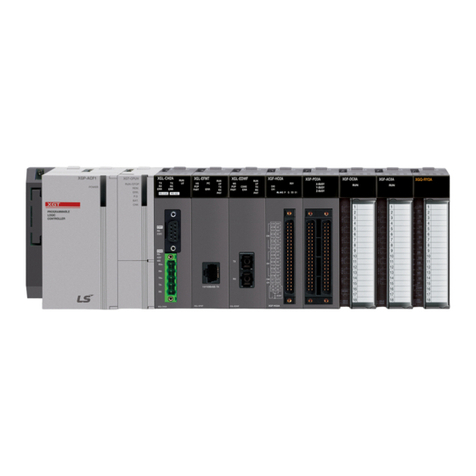
LSIS
LSIS XGT Series user manual

Grohe
Grohe GROHSAFE 3.0 35 11 Series owner's manual

Emerson
Emerson ANDERSON GREENWOOD MARVAC 121 Series Installation and maintenance instructions

Vortice
Vortice SCNRL5 Instruction booklet
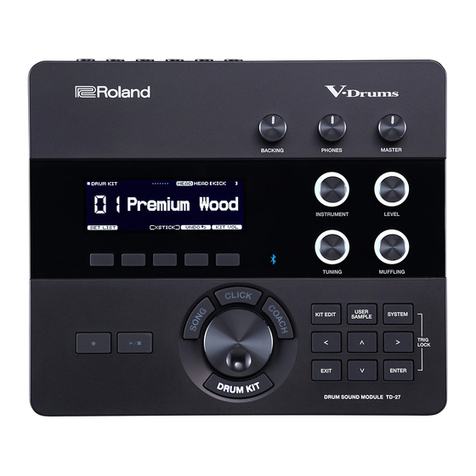
V Expressions
V Expressions Roland TD-27 quick start guide
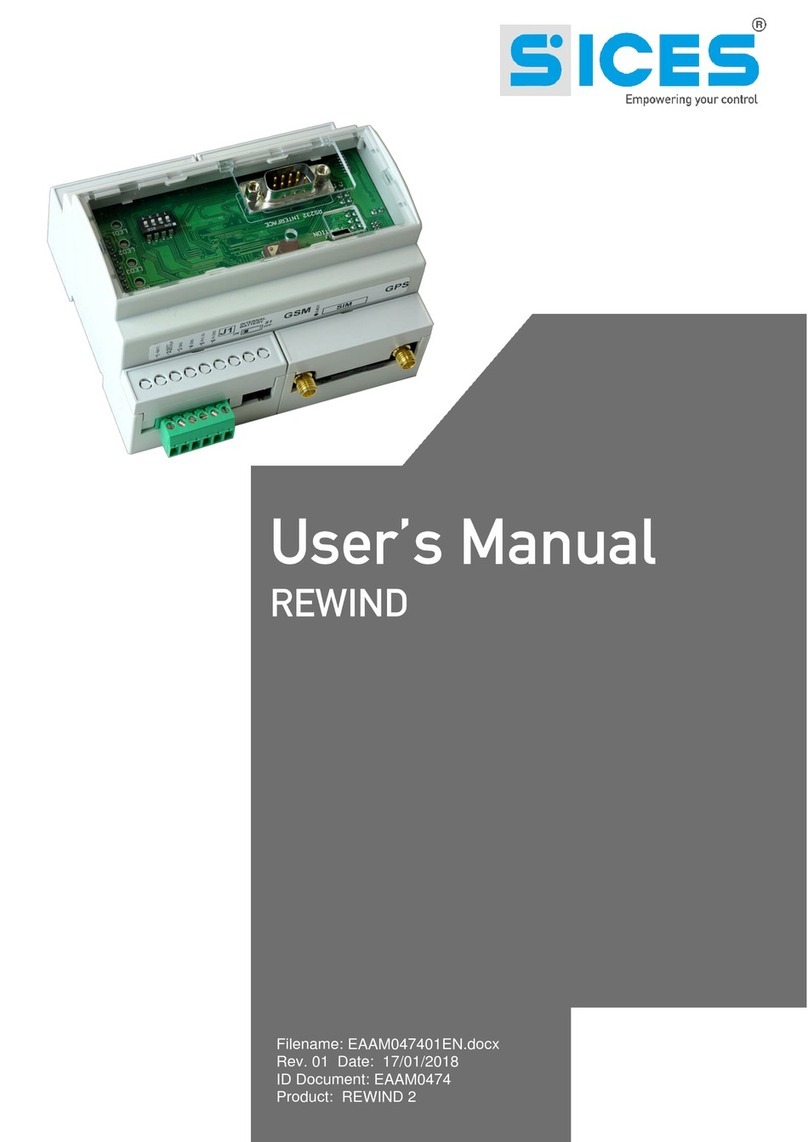
Sices
Sices REWIND user manual
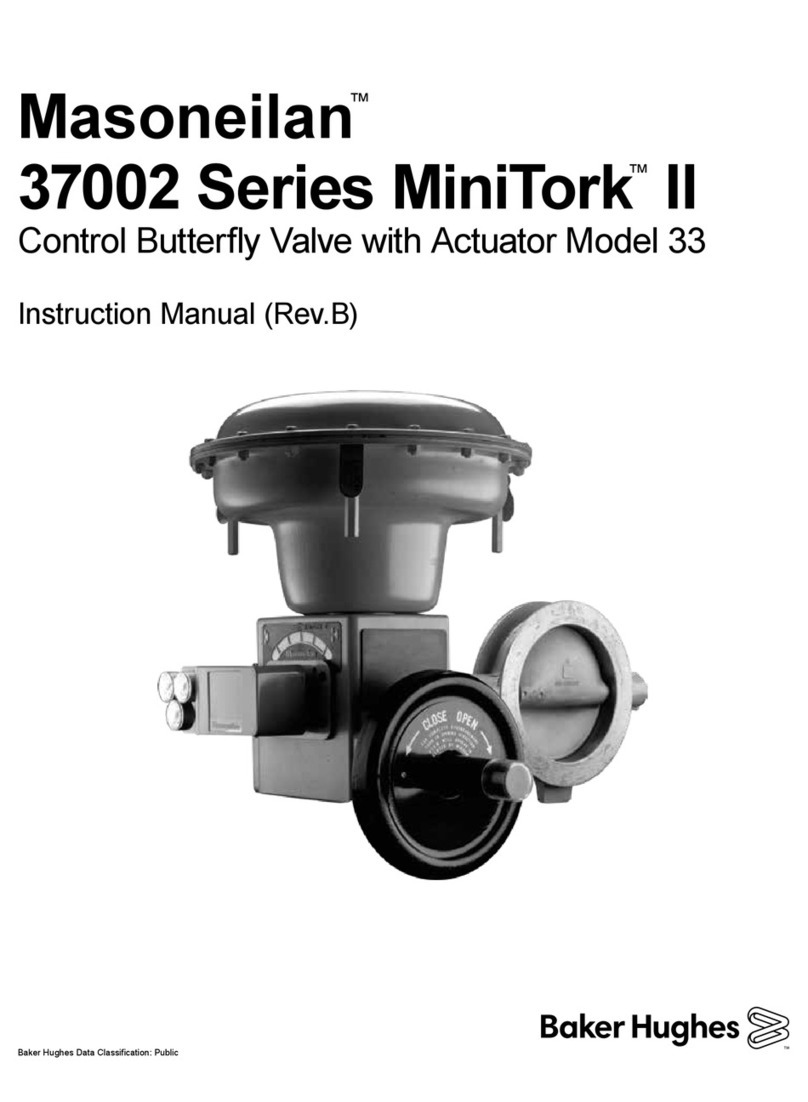
Baker Hughes
Baker Hughes Masoneilan MiniTork II 37002 Series instruction manual
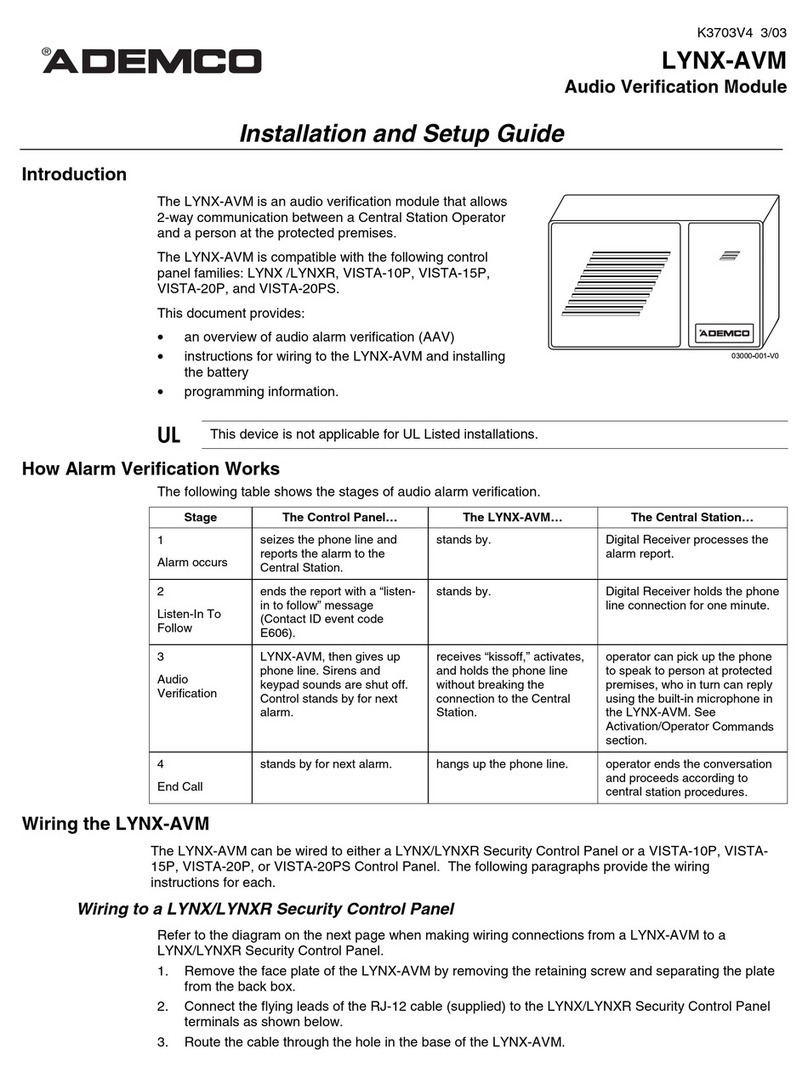
ADEMCO
ADEMCO LYNX-AVM Installation and setup guide
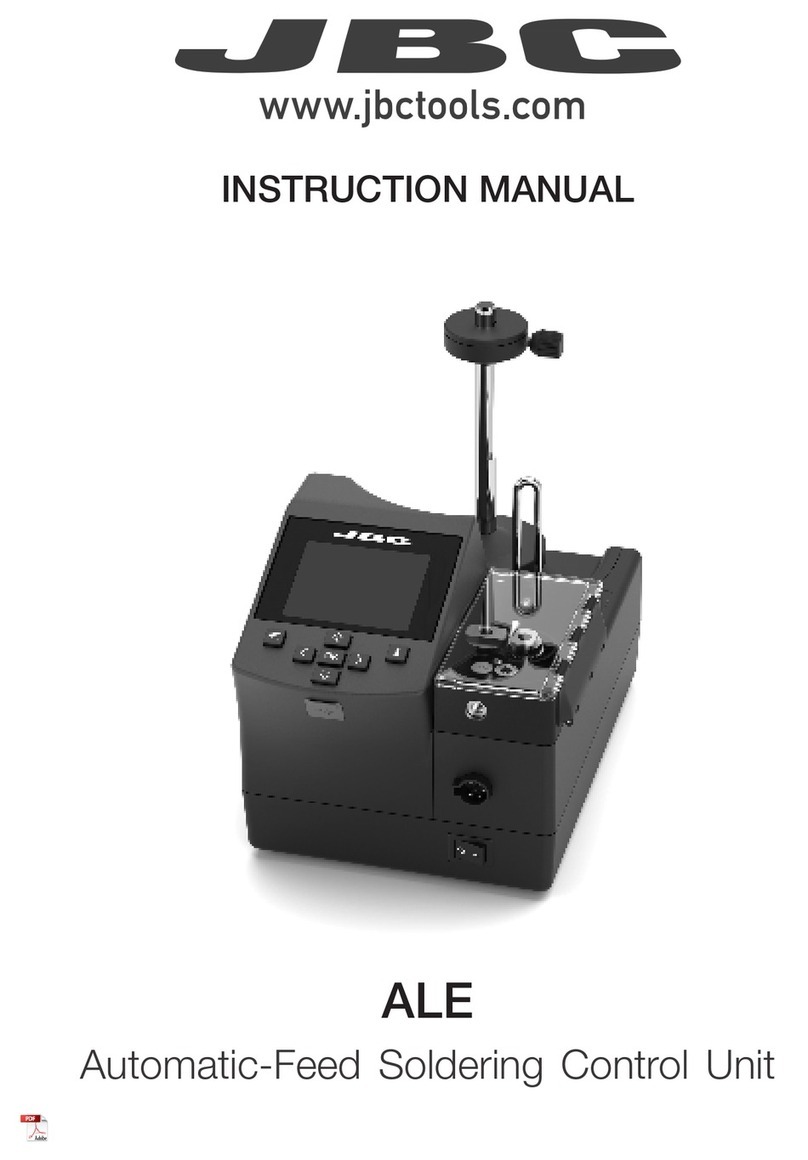
jbc
jbc ALE-908UVA instruction manual

american flame
american flame AF-LMF-RV Installation and operation instructions
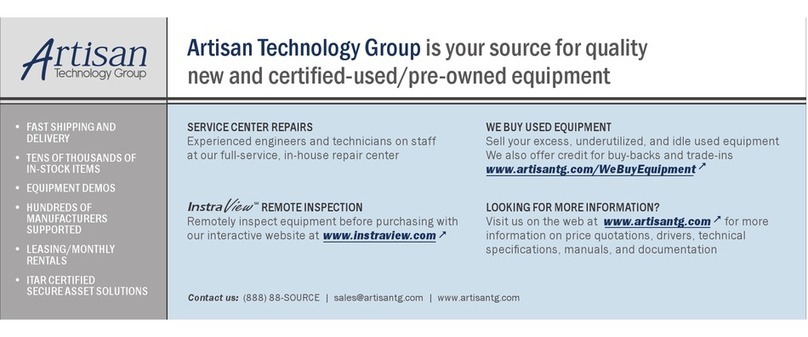
VXI
VXI VT1419A Multifunction Plus user manual
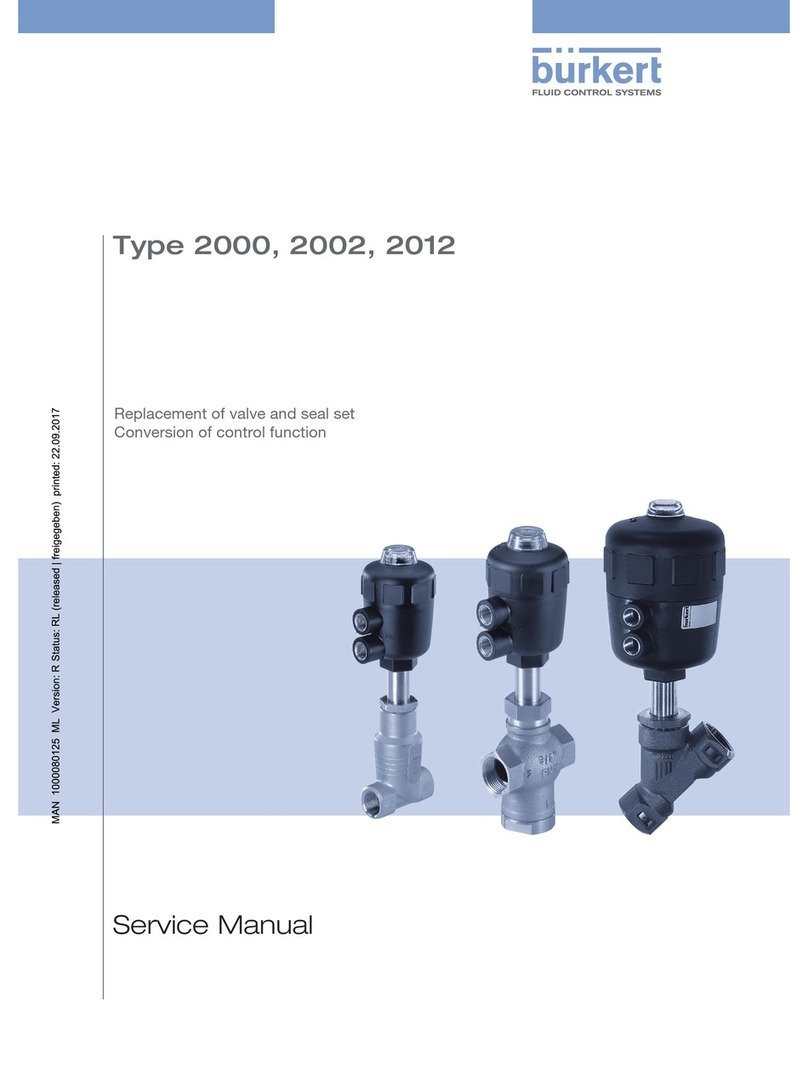
Bürkert
Bürkert Type 2000 Service manual
